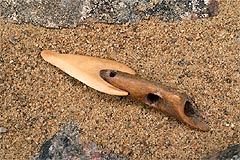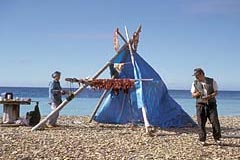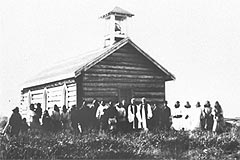 |
Fact Sheet |
Across Time and Tundra: The Inuvialuit of the Canadian Arctic
History of the Inuvialuit
Throughout their history, the Inuvialuit of the Western Canadian Arctic have had to adapt to a challenging environment as well as to frequent and dramatic changes in their relationship with outsiders. Their indelible spirit of survival enabled them not only to prosper in one of the harshest climates on Earth, but also to recover from virtual extinction as a people.

|
Snow goggles 700-800 years old Wood CMC NkRh-3:143 Photo: Harry Foster |
Origins and Traditional Way of Life
The ancestors of the Inuvialuit – and all other Inuit – came from Arctic Alaska to the Canadian Arctic between approximately 800 and 1,000 years ago, according to archaeological evidence. Artifacts discovered at archaeological sites near Pearce Point in the Western Arctic tell us a great deal about how the earliest Inuvialuit lived.

|
Harpoon head Before 1800 Antler, bone blade CMC NlRu-1:55/181 Photo: Harry Foster |
The Inuvialuit have long seen themselves as distinct from other Canadian Inuit. The name they call themselves – Inuvialuit – means "real people." Two hundred years ago, there were about 2,500 Inuvialuit, making them probably the largest Inuit group in Canada.
The Inuvialuit got their main source of meat and fat from sea mammals, including seals, belugas and bowhead whales. They did most of their hunting of sea mammals during the summer, although they also hunted seals through the ice in winter. Hunting could be both difficult and dangerous, particularly since the bowhead whale is the largest animal in the Arctic. A single bowhead whale could provide up to 20 tonnes of meat and blubber.
The Inuvialuit also hunted caribou, which they valued for the animals' meat and hides. Caribou hunting was most intensive in the early fall, when the animals were fattest and their hides were best suited for making clothing.

|
Drying caribou meat Modern Photo: David Morrison |
Although men did most of the hunting, women did much of the fishing. They caught various species of fish year-round using nets. In winter, they hooked fish through the ice. Inuvialuit women were also skilled seamstresses, fashioning warm, lightweight clothes from animal hides.
The Inuvialuit lived almost entirely on the animals they hunted and fished. Each year, they dried and smoked hundreds of kilograms of nutrient-rich meat and fish that they stored for the coming winter. Much of the year, they lived in houses made of sod and driftwood, which they called igluryuat. They entered these homes from below through a long tunnel that acted as a "cold trap" and helped to keep the house warm. Built into each alcove of the house were raised platforms used for sleeping and as an all-purpose living space where people ate, scraped hides and repaired tools.
The Inuvialuit moved with the seasons as different resources became available. During the summer, most people lived in large coastal villages of several hundred inhabitants. These villages were usually made up of several extended families, each one headed by an umialik or "rich man." Although they had few formal powers, these men represented their communities in disputes and provided leadership. Winter settlements were often much smaller and widely scattered.
In Inuvialuit traditional belief, the world was inhabited by spirits, which could be dangerous if they were not treated with respect. The shaman or angatkuq had special powers to intercede with the spiritual world.
The Nineteenth Century
The nineteenth century was a time of great change for the Inuvialuit. Their first meeting with Europeans – a British Royal Navy party exploring the Western Arctic coast in 1826 – nearly ended in bloodshed.
In the 1850s, the Inuvialuit began to trade with the Hudson's Bay Company, which had established trading posts at Fort McPherson and Fort Anderson. They soon became caught up in the fur trade and all it had to offer.
The next major change for the Inuvialuit came with the arrival of American whalers in the 1890s. The whalers brought with them an abundance of trade goods, including cloth, flour and guns. But they also brought infectious diseases that had a devastating effect on the people. By the time the whaling industry collapsed just 20 years later, 90 per cent of the Inuvialuit had died, and their centuries-old way of life had been almost destroyed.

|
Inuvialuit man in a kayak checks his fishing nets, while a whaling
ship cruises offshore. Canadian Arctic Expedition 1913-16 CMC 37133 Photo: Diamond Jenness |
The Twentieth Century
In 1904, the Government of Canada established a police detachment on Herschel Island to keep on eye on the American whalers and maintain Canadian sovereignty. The Inuvialuit therefore found themselves subject to Canadian law.
Soon after the arrival of the whalers, Anglican and Catholic mission churches and schools had been established throughout the Western Arctic. Most Inuvialuit were baptized between 1907 and 1912, although they kept many of their traditional beliefs.

|
Rev. Charles Whittaker and the first communion class 1912 Anglican Church of Canada General Synod Archives P7530-8 |
In the early twentieth century, trapping became a way of life for most Inuvialuit. They supplied furs to the trading posts set up throughout the Western Arctic between 1910 and 1935 by the Hudson's Bay Company and other traders. These trading posts focused on the excellent muskrat trapping in the Mackenzie Delta and fox trapping along the coast.
In the late 1940s, the Government of Canada began to enforce Aboriginal children's attendance at church-run residential schools. Children as young as five were separated from their families for months or years at a time. They were forbidden to speak their own language as part of the government's plan to force them to learn English. Some children also suffered physical and sexual abuse at residential schools.
Inuvialuit children attended residential schools in Aklavik, Shingle Point and Inuvik from the early 1920s until the late 1970s. As a result, several generations of Inuvialuit became separated not only from their families, but also from their language and their traditions.
During the 1950s and 1960s, the Government of Canada encouraged the Inuvialuit and other Inuit to move into towns where government services and some employment were available. Many people found it difficult to make the adjustment to life in permanent settlements.
Today, more than 3,000 Inuvialuit live in the communities of Aklavik, Holman, Inuvik, Paulatuk, Sachs Harbour and Tuktoyaktuk. They live most of the year in these communities where they have their own homes and jobs, and their children attend school. Their ties to the land, however, remain strong, and whenever possible families live "out on the land" in seasonal camps. They travel back and forth to town by boat, snowmobile and all-terrain vehicle. For many Inuvialuit, "county food" continues to make up a big part of their diet.
Despite all the upheavals they have experienced throughout their history, the Inuvialuit's love and traditional use of the land remain unchanged. Their continued reliance on the land through generations has taught them that they must protect it. In 1984, after years of intense lobbying, they signed a land claim agreement with the Government of Canada.
Under the agreement, the Inuvialuit now own outright much of the land in the Inuvialuit Settlement Region. They also have a strong voice in the management of other lands in the region, as well as exclusive hunting, fishing and trapping rights.
Although trapping is still a source of income for some Inuvialuit, the demand for furs has greatly declined in recent years. This decline in demand is due to international embargoes on furs resulting from the lobbying efforts of the animal rights movement.
With the renewal of oil and gas exploration in the Western Arctic, the Inuvialuit are well positioned to benefit from new and exciting resource development projects.
Inuvialuit Elders are greatly concerned about the need to pass on the people's traditions, songs and dances to younger generations. Today, drum dancing has experienced a resurgence, thanks to groups in Aklavik, Holman, Inuvik, Paulatuk and Tuktoyaktuk that perform at home and around the world.
The Inuvialuit are also taking steps to ensure that their language – Inuvialuktun – is not lost. In 1998, they established the Inuvialuit Cultural Resource Centre in Inuvik to help preserve and promote the language that is such an essential element of their culture.
Biography | The Publication | Communiqué
